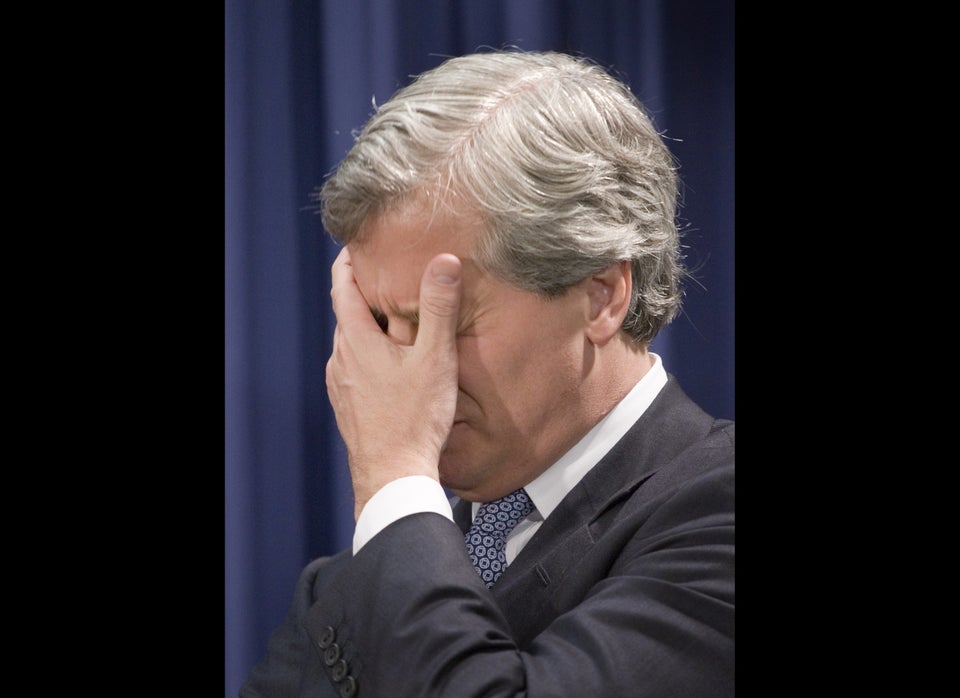
The collapse of Lehman Brothers four years ago today was the Pearl Harbor moment of a financial crisis that, over the next few months, threatened to bring down the entire U.S. financial system.
Blame for the collapse is still being debated. People bought homes they couldn't afford, peddled by lenders who knew -- or should have known -- that the loans were destined to fail. Wall Street sucked up these loans and sold them off in bundles to investors, sometimes while making bets against those same products.
Everyone should have known better. At the top of this list were the government regulators who are supposed to protect the economy from Wall Street excesses, but who instead sat and watched as a bubble built of rotten subprime loans kept expanding.
After regulators forced the shotgun wedding of the investment bank Bear Stearns to JPMorgan Chase in March 2008, the Federal Reserve Bank of New York and the Securities and Exchange Commission sent teams of observers to Lehman Brothers to gather information and monitor the company's condition. Like Bear Stearns, Lehman Brothers had invested heavily in mortgage bonds.
Instead of sharing their findings, however, as they had agreed to do, the regulators did what regulators too often do: behave like naughty 2-year-olds hoarding a new toy. Had they shared information, they would have discovered that Lehman's statements about the robustness of its liquidity were false, according to an independent examiner appointed by the bankruptcy court to determine what had gone wrong at Lehman.
But they didn't see it coming. And when it finally became clear in the week before Lehman fell apart that disaster was imminent, regulators claimed that they didn't have the tools to prevent its collapse. Lehman's lawyers warned that an unplanned bankruptcy would lead to "armageddon." Regulators let it fall, only to watch in horror as the entire U.S. financial system began to unravel, and lending of all sorts came to a halt.
It is impossible to say how the last four years would have unfolded had regulators, upon discovering Lehman's failings, sounded warnings earlier about the instability of the nation's largest banks. It is also not clear whether an orderly unwinding of Lehman from world financial markets would have significantly altered future events.
But here is a safe bet, economists and financial crisis scholars say: The financial system hasn't yet been purged of greed, irrational exuberance or willful misconduct. Another crisis will come.
Are regulators now better equipped to sniff out and prevent a disaster in advance -- or to manage the collapse of a major bank if they don't?
Most of these experts I've spoken with recently say that the Obama administration's financial reform efforts have fallen fall short of their goals. They are also not convinced that our financial system could withstand the shock of the collapse of another major bank.
"I don't see anything that has dramatically changed to keep this from happening again," said John Coffee, director of the Center on Corporate Governance at Columbia University. "All bubbles usually catch regulators on the blind side."
"I'm not all that optimistic," said David Skeel, a University of Pennsylvania law professor who has written extensively about the financial crisis. "The longer we go without firm controls in place, the more dangerous it is."
By one important measure, the risks to the financial system of a bank collapse have only grown. That's because the banks themselves are even bigger than they were four years ago.
Wells Fargo, for example, doubled in size when it swallowed Wachovia. It now serves 70 million customers and manages one out of every six mortgage loans.
Bank of America's assets have increased to $2.1 trillion from $1.8 trillion in 2008.
JPMorgan Chase, the biggest U.S. bank, with $2.3 trillion in assets, is nearly three times as big as it was in 2002, and intends to stay that way. "There are huge benefits to size," CEO Jamie Dimon said this week. "Big banks have a function in society."
His bank, he said, "provided a port in the storm" during the crisis.
Dimon's argument -- which glosses over the fact that homeowners and small businesses weren't allowed to dock at his bank's port -- has some merit. There aren't many banks that can digest a $6 billion trading loss with barely a burp, as JPMorgan recently did. It is also true that the big banks that survived the crisis have paid off all of their government bailout money, while many of the smaller institutions have not.
Still, as we learned during the crisis, size is no insulation against a full-fledged panic. The biggest banks are tied together through an endless series of loans, bets, side bets and even bets on whether each other's financial products -- investments that they don't even own -- will succeed or fail. Just because JPMorgan rode out the crisis better than most of its competitors doesn't mean that it would have done so had taxpayers not come to the rescue, pouring $700 billion into the financial system.
'It's not hard to weather a storm if the government is propping you up," Skeel notes.
STILL WAITING FOR REFORM
After the health care overhaul law, the Dodd-Frank Wall Street reform bill, which Obama signed into law in July 2010, is probably the president's signature legislative achievement -- for better or worse.
The law, in 2,319 pages, aims to do an awful lot. It creates a new federal bureaucracy, the Consumer Financial Protection Agency, to monitor the financial system for harmful products and practices. It lowers the fees that banks can charge merchants when a customer pays with a debit card. It seeks to lessen the dependence of the financial markets on credit rating agencies, which proved completely unreliable in their evaluation of financial instruments made out of mortgage loans.
But viewed broadly, it seeks to accomplish two basic goals. First, give regulators the tools they didn't have the last time around to seize a faltering bank, and then break it apart in a way that doesn't spark a full-fledged financial panic. And second, make the financial markets more transparent, so that regulators have a better chance of spotting the next crisis before it bubbles over.
On these fronts, Dodd-Frank has been less successful than many reformers hoped.
In July, for example, the Commodity Futures Trading Commission (CFTC) approved new rules that will allow regulators for the first time to monitor the domestic derivatives market. Yet regulators are still debating how to monitor derivative trading by U.S. banks that happens overseas. Worldwide, the trades on this market are valued at an incredible $648 trillion.
On Thursday, CFTC Commissioner Mark Wetjen said in a speech that there is a "very real danger that risks undertaken abroad can seriously impact the health of financial institutions, and the broader economy, here at home," according to The New York Times.
That's because banks can also make bets on sovereign debt -- a literal gamble on whether a nation will default on what it owes. As of the end of July, five large American banks, including JPMorgan and Goldman Sachs, had more than $80 billion of exposure to the European countries most likely to default -- Italy, Spain, Portugal, Ireland and Greece -- according to a New York Times analysis of the banks’ financial disclosures.
The financial services industry has also flooded Washington with lobbyists who have worked feverishly to delay, weaken or block implementation of the Dodd-Frank reforms.
In the first two quarters of 2012, for example, the American Bankers Association spent $4.6 million to lobby on topics including Dodd-Frank. Over the same period, the U.S. Public Interest Research Group, one of the consumer-focused groups fighting for Wall Street reform, spent less than $200,000.
There's evidence that this money translates into better access to those crafting the rules. Between July 2010 and October 2011, bank lobbyists hoping to chip away at one key provision -- the so-called "Volcker Rule" that would force banks to stop most trading for their own benefit -- had met with federal regulators 347 times. Public interest, labor, and other pro-consumer advocacy organizations had 18 meetings with regulators over that span.
So far, it appears the banking industry's lobbying push is working. As of Sept. 4, regulators had missed the deadline to finalize 145 regulations required by the law, according to the law firm Davis Polk. Fewer than one-third of the 398 rules mandated under the financial reform law are in place. Full implementation could take several more years.
It is still too early to predict the outcomes of many of the fights over individual reforms. But the financial industry recently scored a big win, when SEC Commissioner Luis Aguilar sided with it by voting against an effort to tighten rules governing money market funds. These are the funds, promoted by investment companies like Fidelity and Vanguard, that traditionally were considered as safe as cash, but with a higher return. Soon after Lehman collapsed, however, one of these funds "broke the buck," meaning that the value of investments slipped below the $1 break-even threshold.
Regulators had wanted these investment firms to insure themselves against potential losses, but that didn't happen. As a result, these funds remain especially vulnerable to a "run on the bank" that could mean big losses for investors, said Coffee, the Columbia professor.
Aguilar, who has otherwise been an advocate for tough regulations, was the third and deciding vote against the proposal. He is a former attorney for the money market industry.
TOO BIG TO UNWIND
Perhaps the biggest question involving financial reform is what regulators would do if another big bank, like Lehman, was teetering on the edge of collapse.
Dodd-Frank created the Financial Stability Oversight Council, made up of the lords of regulatory Washington, including Treasury Secretary Timothy Geithner, Federal Reserve Chairman Ben Bernanke and SEC Chairman Mary Schapiro. The council has the power to seize a failing bank and unwind it in an orderly way. But as with so much else in the financial reform law, how that would happen in real-time is very much a mystery.
Congress's intent was to end the notion that any bank could be “too big to fail.” This, said Skeel, is the "thou shalt liquidate" provision of the law. Those institutions deemed important to the financial system's stability are required to submit living wills to regulators. These roadmaps are intended to explain to regulators how to shut down a bank's business operations.
Lehman Brothers didn't leave a will, and the bank's undertakers are still working to unwind all of its investments.
In a recent report, the Federal Deposit Insurance Corporation, which would manage this unwinding, estimated that, had these new rules been in place in 2008, unsecured creditors of the parent company would be due far more than they are under the most recent bankruptcy plan -- 90 cents on every dollar of claims, compared with the roughly 20 cents they can now recover.
The regulator's report imagines a past in which Lehman underwent an "orderly liquidation" instead of a sudden collapse. Despite the incredible complexity of such a process, the gains would have been "vastly superior for systemic stability," according to the report, which also found that taxpayers and creditors would have been better off.
Yet any liquidation would probably require a massive cash infusion, at least initially, in order to hold a bank together while it is broken apart, said Arthur Wilmarth, a banking law professor at George Washington University.
"If you try to accomplish something on the magnitude of Citigroup or Goldman Sachs, can you really contemplate that the FDIC can handle it without a disguised bailout?" he asked. "What will happen if all of them are in trouble?"
Wilmarth said he didn't have an answer to his questions.
"What we see is that the institutions are bigger than ever before and more complex than ever before. In terms of what we have accomplished, we are somewhat better off," he said. "But I think there are still a lot of unanswered questions and [regulators] haven't been near tough enough."
Also on HuffPost:

